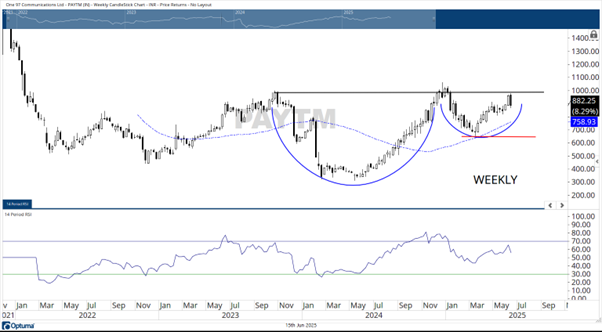Upstox Originals
PAYTM's teacup: Brewing up a breakout

5 min read | Updated on June 16, 2025, 15:33 IST
SUMMARY
A few technical formations are as popular or sought after as the elusive ‘Cup and Handle’ formation. A bullish signal, it helps identify high-potential trading opportunities. Learn its structure and see a practical application through PAYTM, poised for a potential breakout. While powerful for identifying strategic entry points and projecting targets, always remember that no pattern is foolproof.
Stock list

The PAYTM stock is currently exhibiting a cup and holder pattern
Technical Analysis is a method of evaluating securities by analysing historical price movement and volume data. Unlike fundamental analysis, which focuses on a company’s financials and intrinsic value, technical analysis is grounded in the belief that all relevant information is already reflected in the price. One of its core principles is that price movements are not random but often follow recognizable patterns over time.
These patterns, shaped by market psychology and investor behavior, provide valuable insight into potential future movements. Among these, chart patterns serve as critical tools for identifying trend continuations or reversals. Understanding these patterns enhances the ability to anticipate market behaviour and construct disciplined, evidence-based trading strategies.
Understanding the Cup and Handle Pattern
The Cup and Handle is a bullish continuation pattern that signals a potential breakout to higher levels following a period of consolidation. It derives its name from its visual resemblance to a teacup, where the price first undergoes a rounded bottom (the "cup") followed by a shorter, downward-sloping consolidation or pullback (the "handle").
This formation typically occurs after an existing uptrend and suggests that the stock is pausing before resuming its upward trajectory.
The “cup” portion reflects a gradual shift in market sentiment—from a decline to stabilisation and eventual recovery—indicating accumulation and reduced selling pressure. The “handle” often takes the form of a flag or small downward channel, representing a minor shakeout or profit booking phase. Once the price breaks out above the resistance formed by the rim of the cup, it typically signals renewed buying interest, often accompanied by increased volume.
This pattern is particularly useful for identifying high-probability trading opportunities, as it combines elements of trend continuation and consolidation. The Cup and Handle provide a clearly defined entry point—usually above the handle’s resistance—and a logical stop-loss placement just below the handle’s low. Additionally, the pattern’s structure allows for a measured move target based on the depth of the cup, making it a practical tool in both discretionary and systematic trading approaches.
Double Top within a Cup: A deceptive reversal signal
In a typical Cup and Handle formation, the initial price action may resemble a classical double top, where the stock forms two peaks near a common resistance level. This setup often raises expectations of a trend reversal.
However, in this context, the double top proves to be a false signal. Instead of triggering a sustained downtrend, the price undergoes a brief retracement and then enters a consolidation phase.
This consolidation marks the beginning of the "cup" structure, as selling pressure diminishes and buyers gradually regain control. Over time, the price recovers and retests the previous highs, forming a rounded base. This deceptive setup traps early bears and strengthens the bullish case as the pattern transitions into a well-defined Cup and Handle, with potential for a breakout above resistance.
Case study: PAYTM – A classic Cup and Handle formation in progress

The weekly chart of PAYTM illustrates a textbook Cup and Handle pattern. Initially, the stock formed a classical double top near the ₹980–₹1000 range—a key resistance level. While such formations typically signal a reversal, PAYTM defied expectations. Instead of breaking down, the price merely retraced briefly and entered a phase of sideways consolidation while taking support at its 50-week MA, forming the “handle” portion of the pattern. The price is now gradually rising again, retesting the neckline around ₹1,000.
This price behaviour completes a well-formed Cup and Handle structure, suggesting a potential bullish breakout. However, it is critical to wait for confirmation. A valid entry would only be triggered if the stock moves convincingly above ₹1,000, ideally backed by a surge in volume. Preempting such patterns can lead to false signals—therefore, traders must exercise discipline and act only on confirmed breakouts. Confirmation enhances probability and provides a clearer risk-reward setup.
Breakout Implications and invalidity levels
If PAYTM manages a decisive breakout above the ₹1,000 neckline, it would confirm the Cup and Handle formation and potentially trigger a strong upward trend on higher time frame charts. Such a breakout often signals the start of a sustained bullish phase, supported by renewed investor confidence and increased participation.
The pattern’s depth also allows for projecting a reasonable upside target based on the height of the cup, potentially at ₹1,375. However, it is equally important to monitor invalidation levels. A breakdown below ₹645—the lowest point of the cup—would negate the entire formation. This would imply structural weakness, invalidate the bullish setup, and could potentially attract fresh selling pressure.
Conclusion: Strategic Value of Pattern-Based Entries
Cup and Handle breakouts, when confirmed with price and volume, offer high-probability entry points that can significantly enhance portfolio performance. These formations represent periods of consolidation followed by renewed strength, capturing both market psychology and institutional accumulation.
Entering a stock like PAYTM upon a confirmed breakout above a well-defined resistance level allows investors to align with emerging trends early in their development. This not only improves the reward-to-risk ratio but also supports disciplined capital deployment within a structured technical framework.
Moreover, such setups typically occur on higher time frame charts, adding durability and trend sustainability to the trade. Integrating these entries into a broader portfolio strategy can improve consistency, minimise emotional decision-making, and support long-term capital appreciation. However, adhering to confirmation and respecting invalidation levels is essential to preserve capital and maintain tactical discipline.
By signing up you agree to Upstox’s Terms & Conditions
About The Author
Next Story
